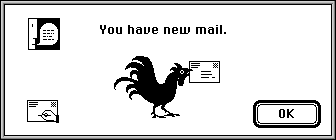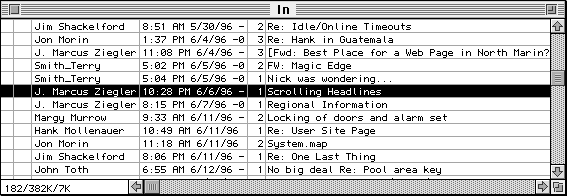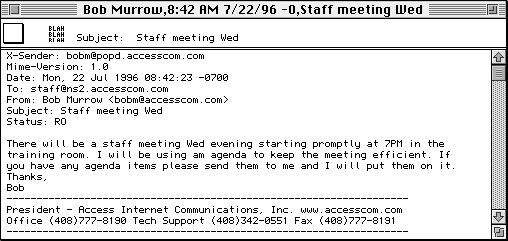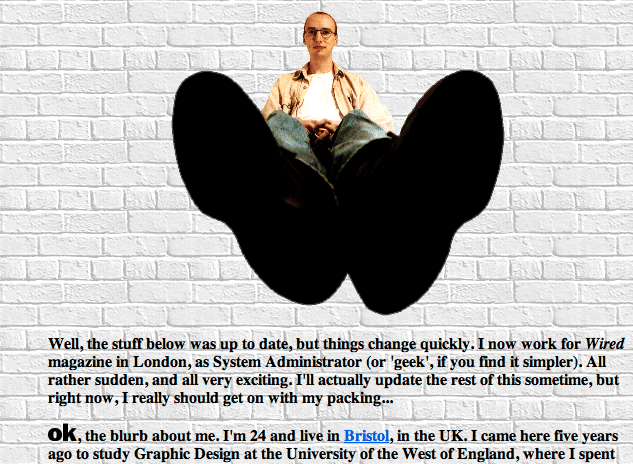In early 1995 I was 23 and living in a terraced house in Bristol with four friends, about 18 months after leaving university. I’d given up on trying to be an illustrator, had a bit of freelance work making models for Aardman Animations, and would soon be the only one of my friends not to have permanent work. I was increasingly interested in technology and this brand new thing: Internet.
The previous year I’d discovered Wired magazine, then only available at a handful of shops imported from the US. On the rare occasions the mainstream media mentioned the internet it was explained as something like, “an international network of computers”, and Wired was a revelation to me, bringing together lots of things I was interested in. There are other people who get this!
§ Late
By the time I could get online I felt I was late. For Christmas I’d received some money that I could put towards buying a modem. Several months earlier I’d bought an Apple Macintosh LC – 10MB of RAM, 40 MB of storage – from my friend R who was upgrading to a newer model, better suited for developing multimedia CD-ROMs.
A US Robotics 14,400 modem – a small box that would connect my Mac to the telephone line and onwards to the internet – would cost me £172.13 including postage (equivalent to £357 in 2025).
 A US Robotics Sportster 14,400 Fax Modem from the Centre for Computing History
A US Robotics Sportster 14,400 Fax Modem from the Centre for Computing History
As its name implies, this would provide an internet connection with a speed of 14.4Kbps, or 0.014Mbps in modern-day units. Which sounds slow, and it was.
I bought that from Demon Systems who were also about the only providers of affordable access to the real internet at the time, as opposed to AOL’s and Compuserve’s closed networks. That connection cost £12 per month (£25 today), on top of which I’d have to pay for phone calls: 1p for every minute I was online, so long as it was off-peak (weekday evenings or at the weekend).
I also needed some special software to enable my Mac to get online: MacTCP. Internet connectivity wasn’t yet built into the Mac’s operating system and this extra floppy disk alone cost about £60 (£124), as far as I remember. But if you bought the Internet Starter Kit book by Adam C. Engst MacTCP was included alongside other useful programs and almost 1,000 pages of valuable information. You can still read the third edition online.
 My copy of the Internet Starter Kit
My copy of the Internet Starter Kit
§ Connected
It’s hard to convey how difficult it was to set things up. So new and alien to me. When reading computer magazines I’d always skipped articles about networking and, while the computers at university had been connected together, that was only for the purposes of printing, scanning and transferring files.
First there was the issue of getting online at all. The Internet Starter Kit spent 59 pages explaining how to set up MacTCP, and PPP or SLIP, two different methods of connecting to the internet, the differences of which happily escape me now. I spent a lot of late nights fiddling with control panels and extensions, learning about IP addresses, domain name servers, etc.
 A screenshot of MacTCP from Macintosh Repository
A screenshot of MacTCP from Macintosh Repository
I’ve pulled out some relevant bits from my diary in 1995, excerpted below. I’ve added some formatting and changed names to initials.
Friday February 17th 1995 1.50 am
Well, I’ve been spending much of the last couple of weeks or so connected to my Mac. Since getting a modem at the start of the month, and hooking up to the Internet, I’ve spent about an hour every evening actually online (which I guess is costing me about £1 a night), and much of the days and early evenings fiddling about with things. It’s so complicated. All the hype never mentioned that. I guess journalists just have it all set up for them so they don’t have to worry too much about that side of things. It’s been a nightmare, but an enjoyable one, and in the end, satisfying.
§ Cyberspace
To get online, once things were finally working, I had to make sure no one else in the house was going to use our one landline phone (not that the word “landline” would have made much sense in those pre-mobile phone days; it was just the phone).
The Sound of dial-up Internet
Then I connected the phone cable to my new modem which was plugged into my Mac. I guess – I don’t remember – I had to open the MacPPP control panel and click the “Open” button, which would initiate a sequence of sounds that are Proustian in their significance for anyone of the era.
Once online there was another set of new things to get my head around. The Internet was made of different parts, each with their own choices of software for using them. There was, of course, email – for which I used the dependable Eudora – and the World Wide Web. The first graphical web browser, Mosaic, came out less than two years earlier but I can’t recall if I used that or MacWeb or both.
Sometimes I needed more than one program to access a single thing. Usenet newsgroups are still going and back then they were the primary way of communicating with strangers about different subjects. Imagine if your favourite social media service was divided into thousands of topic-based sections, organised in a hierarchy, and all the posts were like text-only emails. And no one was in charge. That was, sort of, Usenet newsgroups.
Friday February 17th 1995, continued
The biggest problem was getting my newsreader sorted out. I’ve got MacSlurp to get the news from Demon, ToadNews to convert that into actual messages (which it’s actually doing as I’m writing, albeit rather slowly), and rnMac to read the messages. But I couldn’t get the latter to work properly, and had to ask if anyone on the comp.ip.support.mac group had had a similar problem (it’s a common combination of programs). They had, and one guy gave me a solution to getting TheNews to work in place of rnMac for the time being, and then this guy Alan Staniforth helped me via Email to get rnMac working, which was great of him, and has been the best thing of my first fortnight in ‘cyberspace’.
Like the early days of any technology – radio, cars – there was a sense of tinkering, piecing things together, basic but exciting tech finally working, tools evolving rapidly. And very little of it all was commercial. I found the floppy disks on which I backed up my internet-related software and I think that MacTCP is possibly the only pay-for thing there. The rest are, I think, open source, or developed at universities, or free versions of pay-for software:

Here are links to most of those programs (“apps” was a long way off as a term) in the online archive of the Internet Starter Kit:
- Basic connection: MacTCP, MacPPP, ZapTCP
- Email: Addmail and Eudora
- Usenet: MacSlurp, Toad News, rnMac
- Gopher: Turbogopher
- FTP: Fetch, Anarchie (also for searching Archie servers)
- IRC: Homer
- Telnet: NCSA Telnet
- WAIS: MacWAIS
- Finger: Finger
§ Absorbed
Friday February 17th 1995, continued
In fact I can see how people get completely absorbed by the Net. My life over the past couple of weeks has been, and all I can think about to say to people in real life is things I’ve heard in rec.arts.tv.uk or something. But I have had a few notes from S [my sister], who can use it at college, which is great. It just feels nicer, writing than phoning. I really do like Email. Had a couple of messages from T, a couple from M […]. But I really do need a faster, bigger Mac…
Must go now, as I don’t have enough memory to let rnMac thread the newsgroups and run Claris at the same time.
I spent quite a bit of time reading Usenet that year, downloading the groups I subscribed to, reading them offline to save money on the phone bill. I can’t recall which I read, apart from some HTML-related groups (while I learned to make my first web pages) and some UK-specific ones.
It didn’t take long for me to become impatient with people posting things I deemed unacceptable, such as this from rec.arts.tv.uk:
In article <[email protected]>, Phil Emery writes: > > Natalie Cooper ([email protected]) wrote: > : Can anyone remember the Adventure Game? And the guy who talked > : backwards and Uncle who was a pot plant in one series and a tea > : urn in another? Am I getting this right? It was one of my > : favourite programmes but I can't remember much about it any more > : ... <sob> Help! > > And the funny money that they was linked to some kind of game. And the VORTEX. > I was only about 10 or 12 when they showed it. It scared me ! > Oh please. I've only been on the net since the start of February, and this repetition of an already over discussed topic makes me feel like an old hand! Phil Bristol, UK [email protected]But aside from twats like me, there, it was generally friendly. People posting using their full names and sharing their email addresses for all the world to see. It helped, of course, that it was a pretty homogenous little world: no doubt mostly white, middle class, and college-educated (especially given the percentage of people logging on for free from their universities). Little fear of stalking, doxxing, spam, etc.
§ Wonders
When I got online I think I only knew three other people who already had internet access, none of whom were among my friends in Bristol. I’d occasionally try to demonstrate the wonders of the Internet to friends, them sitting on the edge of my bed as I sat at the desk and logged on to show them this largely text-based world.
Reactions were probably split between amazement and bemusement. Now that we’re used to instant connection to anyone in the world for almost free – via video and voice, never mind text – it’s hard to recall that once this was hard to believe. If I logged in to IRC (Internet Relay Chat) or a telnet chat room I might ask someone who was connecting from the US to say hello to my friend. Hey Tim! they might type. Yes, those characters were really typed by someone in California, right now! A real person! Hard to believe.
But other times things didn’t work, or the friend was understandably underwhelmed by seeing black-and-white text scrolling up a computer screen, no matter where the typers were apparently located.
Wednesday, 1st March 1995, 1.40am
Feeling happy and sad. Happy, as I’ve just been out ‘surfing’ on a particularly good trip. I offered to show J [one of my housemates] what’s out there, as I was sure he’d be interested, and he’d never seen it. Showed him a bit of the WWW, which was frustrating, as MacWeb couldn’t get Helpers to play sound or view JPEGs.
Then I tried Homer, to chat on the IRC channels (J had been attracted by the Homer Simpson icon). It automatically logged on to the #england channel, and I began chatting with a guy from Massachusets called sexy, who liked England a lot, and then some other American who also liked England (I guess that was why they were there). I tried opening another channel as well, but as I did so about a dozen people also joined both channels and it got so busy that either the modem or Mac couldn’t keep up, and I couldn’t click on anything. Eventually had to force a quit.
Shame, as it was good chatting to the two blokes. When I’ve been on in the past it’s been busy at the start, and everyone’s having their own conversations. Good to have a chat to someone so far away in real time. It was handy being able to type fast. Feel bad about just leaving the second guy who was swamped with new comers.
Then downloaded Newsgroups, which I’ve just finished reading, which were entertaining as usual, and also a nice quick message from S.
§ Chat
The trouble with real-time communication like chat, compared to download-and-read-offline things like Usenet and email, was that it meant staying online, connected by the phone line, as the 1p minutes ticked by. Every week I put a £5 note in my desk drawer so that when the itemised quarterly phone bill arrived I’d have collected enough to pay my hefty share of the household bill.
Despite the cost I enjoyed chatting, gravitating to telnet-based chat rooms rather than IRC, which I found overwhelming (see this list of IRC Channels I printed out back then). Wired’s website, HotWired (which looked like this) had its own, Club Wired (chat.hotwired.com:2428), and there was another I liked, also based in San Francisco, space bar (spacebar.com:7227).
 The website of space bar, archived in November 1996, screenshot in 2025
The website of space bar, archived in November 1996, screenshot in 2025
At some point the following year I’d visit San Francisco and the Cyborganic house and, as well as meeting various online friends, see the computer on which space bar was running, an idea that would have blown my 1995 mind.
I kept a list of people I’d chatted with to help me remember who was who and here are the names from Club Wired I noted: ajmani, blazen, brid, brid, clannad, cottontail, dharber, diesel8, dpenrice, eperales, falicia, fifi, hedonism, hollydaze, idaho, jaimi, jdoll, jenniferm, jhendrikson, joine, kjersti, kleaver, kwarwick, leia, lilfloater, lorikete, majorite, mediale, merps, miriya, mpnelson, napkin, patrickx, pollyjean, prairiewind, sagola, slloyd, smurfer, stryk, trish, truthgirl, yarol, zoeex. Here’s a website from 1997 listing a lot more “Club Wired People”.
Given that I knew very few people IRL (I knew all the slang!) who were really aware of the net, chatting with people who were as immersed in all of this as much as I was was amazing. We were here in this new world together even if they were thousands of miles away. I was living somewhere else for an hour a day.
Monday 27th March 1995, 8.45pm
It really is like having another life I only enter late at night. To increase this feeling, I’m trying to get on to a MOO/MUD, which look good fun, and the kind of thing that racks up huge phone bills. There’s one called BayMoo, a kind of virtual San Francisco, which sounds good. Really need to meet new people. The good thing about the net, is that it’s so easy to meet and talk to new people – I’d never go into a real pub and start chatting to strangers, but it’s so easy on the net.
I must admit, I never got really into MOOs/MUDs, especially hampered as I was by limited available time, although I spent quite a bit of time in UMOO (moo.cs.uwindsor.ca:7777) and BayMOO (still alive!).
 What you see when connecting to BayMOO, screenshot in NCSA Telnet (running in Mac OS 9 under Mac OS 10.3 in 2025).
What you see when connecting to BayMOO, screenshot in NCSA Telnet (running in Mac OS 9 under Mac OS 10.3 in 2025).
Learning how they worked took time – the “BayMOO Help” file I printed out was ten pages of two-column tiny text. How to move, communicate, create and manipulate objects, build new locations… I stuck to the basics and treated them like fancy chat rooms, making several friends, often shifting to email for longer, asynchronous communication.
I loved email in the late ’90s. Today, my personal email mostly feels like a constant stream of tasks to attend to, even leaving aside the flood of spam that mostly gets diverted away from the inbox.
Back then there was little in the way of spam, as far as I recall. I looked forward to connecting every evening to read the few emails that had arrived. There might be a couple from friends I’d met online sharing what they’d been up to, in a way we tend not to use email these days. Perhaps one from someone replying direct to me after a post on Usenet. Another from one of my very few real-world friends with email. And maybe one of the newsletters that I subscribed to.
 The welcome sight of Eudora’s “You have new mail” dialog, taken from this old guide
The welcome sight of Eudora’s “You have new mail” dialog, taken from this old guide
The program I used to read email was Eudora, and did so for a decade. I loved it and even thought that if I ever had a daughter, Eudora would be in the running for her name. (We can be relieved this did not happen.)
 Eudora’s inbox window, taken from this old guide
Eudora’s inbox window, taken from this old guide
Emails were downloaded to your computer – no webmail in those days – and I’d forgotten until writing this that, at first, doing so required an extra program: as the Internet Starter Kit reminds me, Demon Internet’s service required the use of AddMail to download email and convert it to a format Eudora could read. AddMail was written by the same guy who’d helped me, via email, set up the various programs to read newsgroups.
 An email window in Eudora, taken from this old guide
An email window in Eudora, taken from this old guide
But you could, if your provider allowed it, log in to your server on the command line to check email from other computers. The following year I did this from the Cyborganic house while on holiday and some co-workers thought I was a bit odd for checking my email – something they mostly only used at work – while away.
§ IRL
I have to emphasise again how text-based this was. I ended up meeting quite a few people in the flesh who I first met in chat rooms, MOOs, and on Usenet, and it was pretty rare to have any idea what they looked like before meeting – you couldn’t message someone a quick selfie.
If you wanted to send someone a photo of yourself the process would be something like:
- Take a photo of yourself, or more likely have someone do it for you.
- Take the film to be developed, or send it off in the post.
- Get the photos back and hope the picture is acceptable.
- Find someone or somewhere with a flatbed scanner.
- Scan the photo in, save the file to a floppy disk, and take it home.
- Make sure the file wasn’t too big; if so, somehow process the image to make it smaller.
- Now you can attach it to an email!
Whether you’d shared a photo or not, it was weird to meet someone you only knew online, a wholly new feeling, with no idea what to expect. How did a friendship based solely on internet chat and emails translate to face-to-face friendship? Everyone I met was, thankfully, really nice but it was also clear that what was an easy, and sometimes deeply meaningful, friendship online didn’t necessarily translate well into real life.
I’m sure a lot has been written about this over the decades but there’s something about text-based communication that elides quirks, annoyances and incompatibilities, and alters personalities. When you meet, physical presence, conversational styles, and the reality and complexity of another human is suddenly there, on top of the relatively simple ASCII communication you had before. You can have an easy time nattering away online but meet in person and something just might not click. Maybe you’re both a bit too awkward or you realise you don’t actually have much in common. On the other hand, I knew at least one couple who were engaged after meeting in a MOO and I hope it all worked out for them.
§ WWW
Monday 4th September 1995, 12.06pm
Actually getting somewhere with my web pages now. Have fiddled with lots of graphics, and designed some great backgrounds. In a week or two I should have the space sorted out to actually put them up. Should be good. Already got a picture of me up on the ‘Club Wired People’ page run by Netgenius / S, which is good – SO cool to be chatting to someone and say “Oh, here’s the address of my picture”, and they can go and look at me. When I was chatting to Fifi a couple of weeks ago, it was almost as cool when she asked what I look like, and I could just email her a photo. Of course, it would have been cooler if it had arrived while we were talking, but there we go. I’m trying to make myself not feel so involved in my virtual life now – a night or two with no good conversation, and I realise that it really shouldn’t take over my life – these people could well just vanish and I’d never hear from them again.
I found the web fascinating. Not only was there this seemingly endless inter-linked space of information – with colours and pictures! – but it was possible to make your own pages to put there for everyone to see.
It was slow of course. Although pages were very simple by today’s standards, you still had to be patient waiting for pages to appear over the primitive connection. It was so slow that even though images were small they often had an alternative lowsrc version – low resolution, black and white – that could load more quickly, while you waited for the full version to appear, often one line at a time. But, still, pictures! Design!
It was much easier to make websites back then. For most people’s purposes web pages were nothing but static HTML. There was no JavaScript or CSS, and the HTML was version 2.0, more limited than today’s, and so there was much less to learn. But it was still bewildering, totally new, as I pieced things together from documents like this HTML Primer from the National Center for Supercomputing Applications and the imminent Extensions to HTML from Netscape.
 A newspaper cutting I found among other papers from 1995
A newspaper cutting I found among other papers from 1995
Although making websites was simpler then, it was harder to get a website online than it is today. There were no blogging platforms, no Wix or Squarespace, not even much in the way of web hosting services for the general public. Even finding out what was available was difficult: search engines were primitive and you mainly had to rely on browsing around or word of mouth.
I did hunt down a brief list of places that would host websites for free, quite possibly a category on Yahoo! There were half-a-dozen or so websites listed there and the only one that ended up offering me space was some place called paranoia.com.
For a couple of years my email address was [email protected] and my website was at http://www.paranoia.com/~fabius. Subsequently the domain name, and its many websites that were much stranger than my humble homepage, became the subject of “An Internet Mystery”. See this Reddit post then this one, and/or this YouTube video. I had no idea at the time.
Here’s an archive of my first personal website, from 1995, most faithfully experienced if you can make your browser window roughly 640 × 480 pixels.
 The front of my homepage, screenshot in 2025. Background images had just become possible, hence this.
The front of my homepage, screenshot in 2025. Background images had just become possible, hence this.
§ Miracle
In 2025 we share stuff with the world effortlessly. Have a trivial or, maybe, profound thought? Pop it on social media or, for the old heads, on your blog and then hundreds, thousands or millions of people could read it. Take a photo, press a button and it could be seen by anyone in the world. For better or worse.
Before the web – and all the rest of it – how could you have shared your words with anyone? Write a letter to a newspaper or magazine and hope they published it a few days or months later? Create your own fanzine and distribute copies one-by-one to strangers, and posted in individually addressed and stamped envelopes? That was it, unless you were going to become a successful journalist or writer. Your reach, your world, was tiny.
But now, then, you could put anything you wanted on your own website and instantly it was visible by anyone in the world. OK, anyone in the world who was also online, which wasn’t many then, and they were all quite similar, but, still… they could be anywhere! And their number was growing.
And you could chat to people in real time and it didn’t matter where they were, they were here in front of you. Send emails back-and-forth to friends without writing letters, and buying stamps, and waiting days or weeks for a response. Instant! Weightless!
Discuss topics you’re interested in with strangers all over the world who shared your enthusiasms, quirks, memories, instincts, when no one around you does. Conversations with your people, right there with you and thousands of miles away. The world opened up and your communities in your home.
It was a miracle and it changed my life. All of our lives. Not always for the better: even those of us who were, at times, slightly cynical early on were naive about how ruthlessly and literally carelessly businesses would turn the technologies to their own narrow ends.
The earlier internet was a haven, everyone making it up as they went along. You couldn’t use it to buy stuff and have it delivered the next day, but you could communicate with people, old and new friends, anywhere, instantly. A true, astonishing marvel.
It’s good to remind myself of that. I’m rarely enthusiastic about much but back then all of this grabbed me like nothing else. Probably like nothing else since. I’m very lucky it came along when it did, when I was young enough to make the most of its expanding world, to start a career while everyone figured out what was happening, and to make new friends thanks to it.
 Me in 1995 on my homepage, screenshot in 2025.
Me in 1995 on my homepage, screenshot in 2025.
.png)




